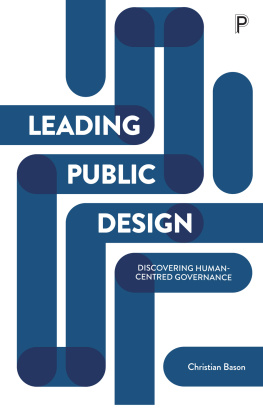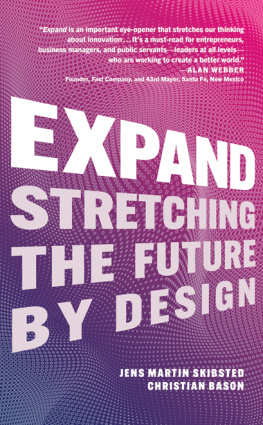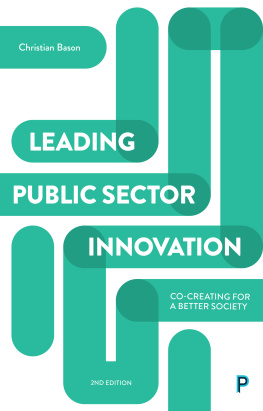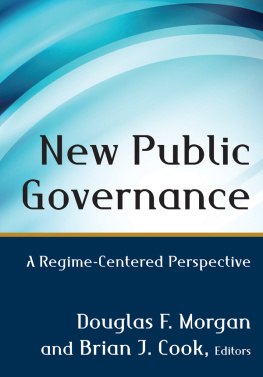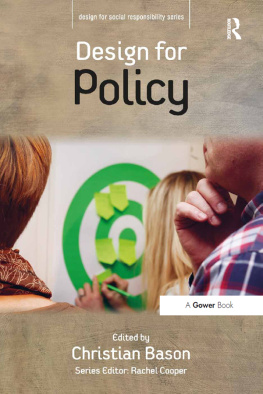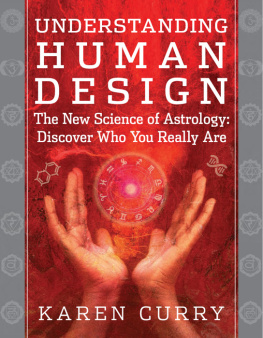Bason - Leading public design discovering human-centred governance
Here you can read online Bason - Leading public design discovering human-centred governance full text of the book (entire story) in english for free. Download pdf and epub, get meaning, cover and reviews about this ebook. City: Bristol Chicago;IL, year: 2017, publisher: Policy Press, genre: Politics. Description of the work, (preface) as well as reviews are available. Best literature library LitArk.com created for fans of good reading and offers a wide selection of genres:
Romance novel
Science fiction
Adventure
Detective
Science
History
Home and family
Prose
Art
Politics
Computer
Non-fiction
Religion
Business
Children
Humor
Choose a favorite category and find really read worthwhile books. Enjoy immersion in the world of imagination, feel the emotions of the characters or learn something new for yourself, make an fascinating discovery.
Leading public design discovering human-centred governance: summary, description and annotation
We offer to read an annotation, description, summary or preface (depends on what the author of the book "Leading public design discovering human-centred governance" wrote himself). If you haven't found the necessary information about the book — write in the comments, we will try to find it.
Bason: author's other books
Who wrote Leading public design discovering human-centred governance? Find out the surname, the name of the author of the book and a list of all author's works by series.
Leading public design discovering human-centred governance — read online for free the complete book (whole text) full work
Below is the text of the book, divided by pages. System saving the place of the last page read, allows you to conveniently read the book "Leading public design discovering human-centred governance" online for free, without having to search again every time where you left off. Put a bookmark, and you can go to the page where you finished reading at any time.
Font size:
Interval:
Bookmark:


First published in Great Britain in 2017 by
Policy Press University of Bristol 1-9 Old Park Hill Bristol BS2 8BB UK Tel +44 (0)117 954 5940 e-mail
North American office: Policy Press c/o The University of Chicago Press 1427 East 60th Street Chicago, IL 60637, USA t: +1 773 702 7700 f: +1 773-702-9756 e:
Policy Press 2017
British Library Cataloguing in Publication Data
A catalogue record for this book is available from the British Library.
Library of Congress Cataloging-in-Publication Data
A catalog record for this book has been requested.
ISBN 978-1-4473-2558-1 paperback
ISBN 978-1-4473-2560-4 ePub
ISBN 978-1-4473-2561-1 Kindle
ISBN 978-1-4473-2559-8 ePdf
The right of Christian Bason to be identified as author of this work has been asserted by him in accordance with the 1988 Copyright, Designs and Patents Act.
All rights reserved: no part of this publication may be reproduced, stored in a retrieval system, or transmitted in any form or by any means, electronic, mechanical, photocopying, recording, or otherwise without the prior permission of The Policy Press.
The statements and opinions contained within this publication are solely those of the author and not of The University of Bristol or Policy Press. The University of Bristol and Policy Press disclaim responsibility for any injury to persons or property resulting from any material published in this publication.
Policy Press works to counter discrimination on grounds of gender, race, disability, age and sexuality.
Cover design by My Buemann, Danish Design Center
Front cover: image kindly supplied by Christian Bason
Readers Guide
This book has been optimised for PDA.
Tables may have been presented to accommodate this devices limitations.
Image presentation is limited by this devices limitations.
For Malene, with love.
This book is the culmination of a journey over the past decade, starting in 2005, where I have become increasingly intrigued by the contribution of design to public sector innovation. This journey has been professional, personal and academic.
Professionally, I have authored a number of books on innovation and leadership in government, where design methods have featured an increasingly central role; I have led the Danish governments innovation team MindLab, which employs professionally trained designers; I have served on the European Commissions (EC) Design Leadership Board and been Chairman of a subsequent EC expert group on public sector innovation (European Commission, 2012; 2013b). My present job, since 2014, is to run the Danish Design Centre (DDC), a government-funded institution that aims to strengthen the use of design by business and society, nationally and globally. Across these professional activities, I have developed a deep personal interest in and curiosity about what design might offer to public organisations and public managers such as myself. As a public manager, what does it really take to engage with design approaches to enact change, not only in discrete projects but also on a wider scale? What are the implications and responsibilities for public managers, and the meaning and sense with which they conduct their jobs? This curiosity has finally led me to an academic journey, where since 2010 I have conducted a PhD project to explore in detail the significance of design work for public managers and for the future of public governance.
This book builds on all of these three journeys. In it, I propose that design approaches can contribute in powerful ways to innovation in the public sector and, potentially, transform how public organisations are governed.
With this foreword I wish to thank the many people who have accompanied me on the journeys and in numerous ways have inspired me to pursue what ultimately has become this book. First of all I wish to thank my thesis advisor at Copenhagen Business School, Robert Austin, who has guided the development of the project from the start. Also, I am indebted to co-advisors Rafael Ramirez of Oxford Universitys Sad Bsuiness School, Banny Banerjee at Stanford University and Dick Boland at Case Western Reserve Universitys Weatherhead School of Management. Also a warm thank you to Eduardo Stazsowski at the New Schools Parsons School for Design, with whom I conducted a visiting scholarship. Along my academic journey I have also been extremely grateful for inputs and ideas from Richard Buchanan, also at Case Western, from Sabine Junginger at the Hertie School of Governance and from Daniel Hjorth, Dorthe Pedersen and Lotte Jensen at Copenhagen Business School.
A range of people in my professional network have been instrumental in supporting and catalysing this work with ideas, suggestions and opportunities to interact. Geoff Mulgan at Nesta has been an inspiration, as have David Halpern of the UKs Behavioural Insights team, and Ann Mettler and Peter Droell, both at the European Commission. Stephane Vincent and Franois Jegou of La 27 e Region have been great collaborators. Martin Stewart-Weeks, Tom Bentley and Nina Terrey have, from their vantage points in Australia, provided many opportunities to present and discuss the work leading up to this book. Charlie Leadbeater, author and speaker, has always provided fresh perspectives and ideas. I must also mention Giulio Quagliotto who has recently challenged my thinking on the intersection of experimentation and design.
This book and the research behind it have depended on the professionalism and world-class work of my former colleagues at MindLab, where many of the networks and relations leading to this book were established. Not least Kit Lykketoft, then Deputy Director, was amazing in the day-to-day running of the organisation during research-intensive periods. Today I am supported by an incredible team at the DDC, where Chief of Staff Anne Christine Lyder Andersen makes sure everything runs smoothly, and COO Sune Knudsen takes care of day-to-day business. Also at DDC, project assistant Paw Whlk did an excellent job as background researcher for this work. MindLab and the DDC are institutions under the auspices of the Danish Ministry of Business and Growth, under the leadership of Permanent Secretary Michael Dithmer. I am grateful that he and his ministry have allowed me to prioritise a research project alongside my management duties.
It goes almost without saying that this book would not have been possible without the 15 public managers who have provided me with their personal leadership stories and experiences of using design. I wish to thank each of them for their time, commitment and openness in sharing their challenges and successes with me.
Once again it has been a pleasure working with the professional team at Policy Press. Last but not least, I must thank my wonderful family my wife Malene and Christopher (12), Julia (9) and Lillian (3) for putting up with another project that turned out to be slightly more consuming than I originally promised!
Christian Bason
Copenhagen, January 2017
To see that a situation requires inquiry is the first step in inquiry . (John Dewey, Logic: The Theory of Inquiry , 1938, p 111)
Carolyn Curtis is a public manager in Adelaide, South Australia. She has been seconded for nearly eight months to a project on how to redesign services for chaotic families. These are families that are typically characterised by high levels of alcohol abuse, violence, unemployment and dysfunction. For the past eight months Carolyn has no longer acted formally as a manager, but has participated with a small team consisting of a designer and a sociologist in exploring how such families live their lives, with the aim of finding new opportunities for helping them to become thriving families. Carolyn says:
Font size:
Interval:
Bookmark:
Similar books «Leading public design discovering human-centred governance»
Look at similar books to Leading public design discovering human-centred governance. We have selected literature similar in name and meaning in the hope of providing readers with more options to find new, interesting, not yet read works.
Discussion, reviews of the book Leading public design discovering human-centred governance and just readers' own opinions. Leave your comments, write what you think about the work, its meaning or the main characters. Specify what exactly you liked and what you didn't like, and why you think so.

